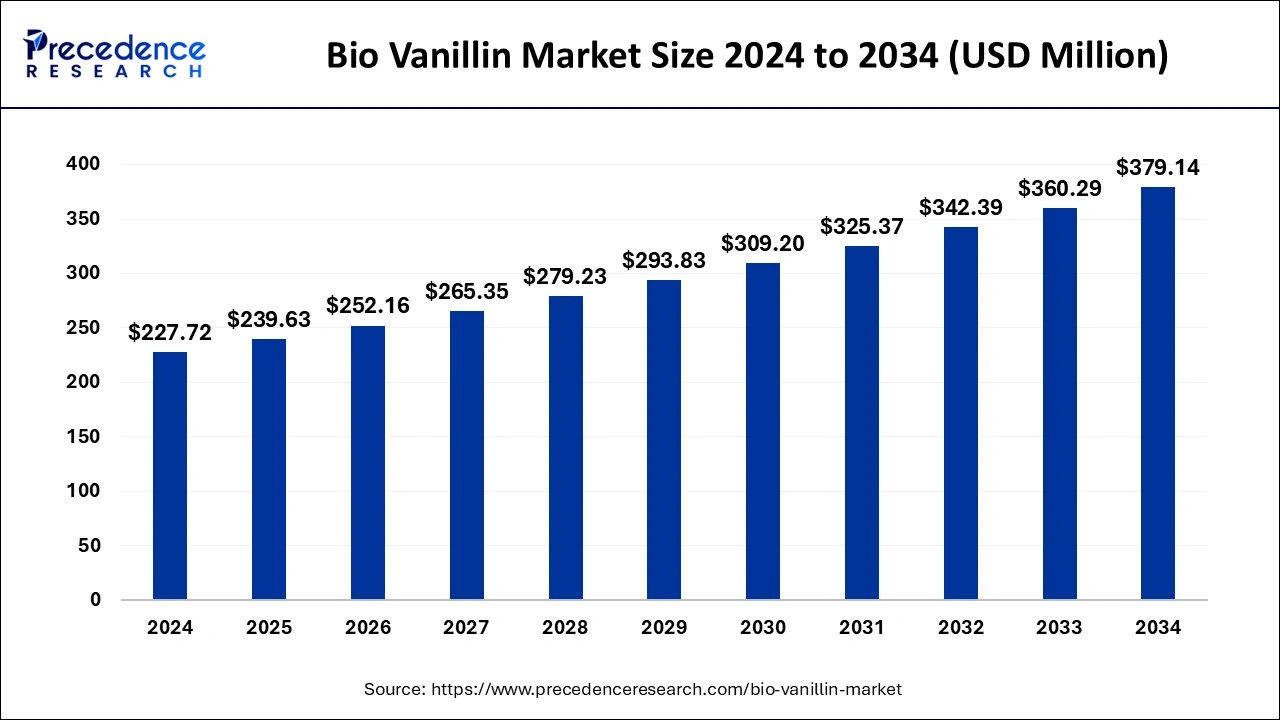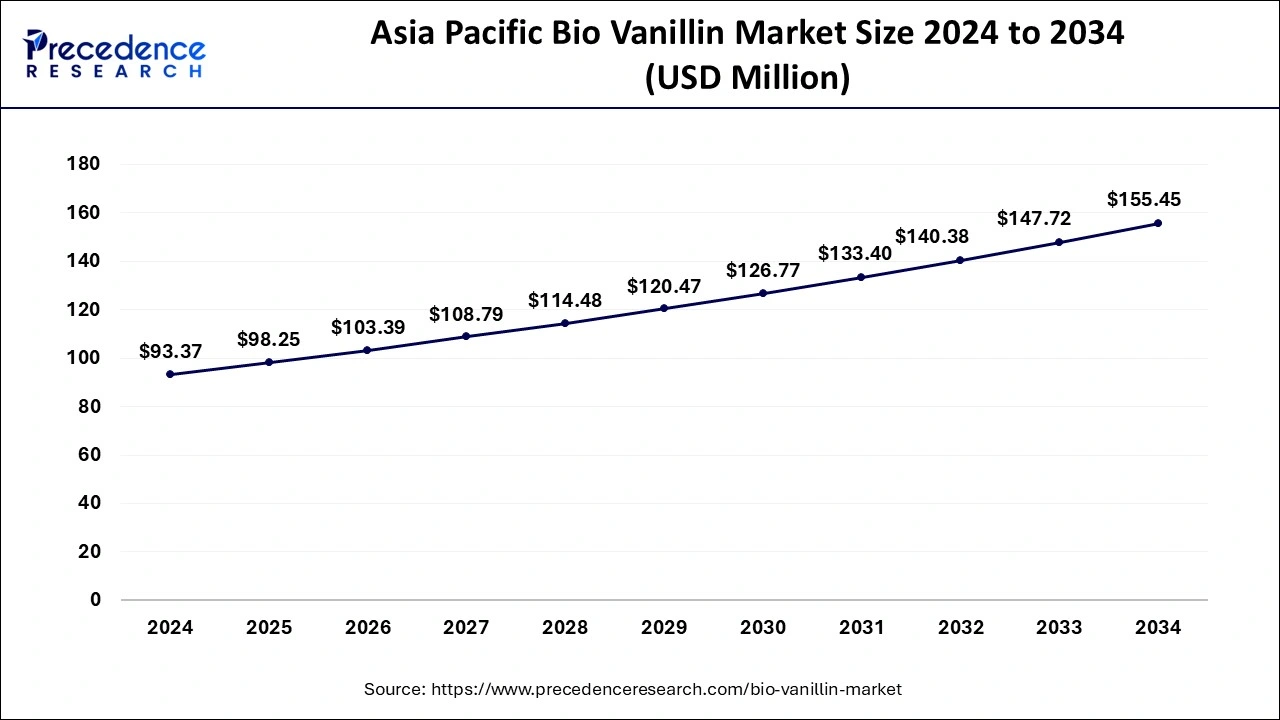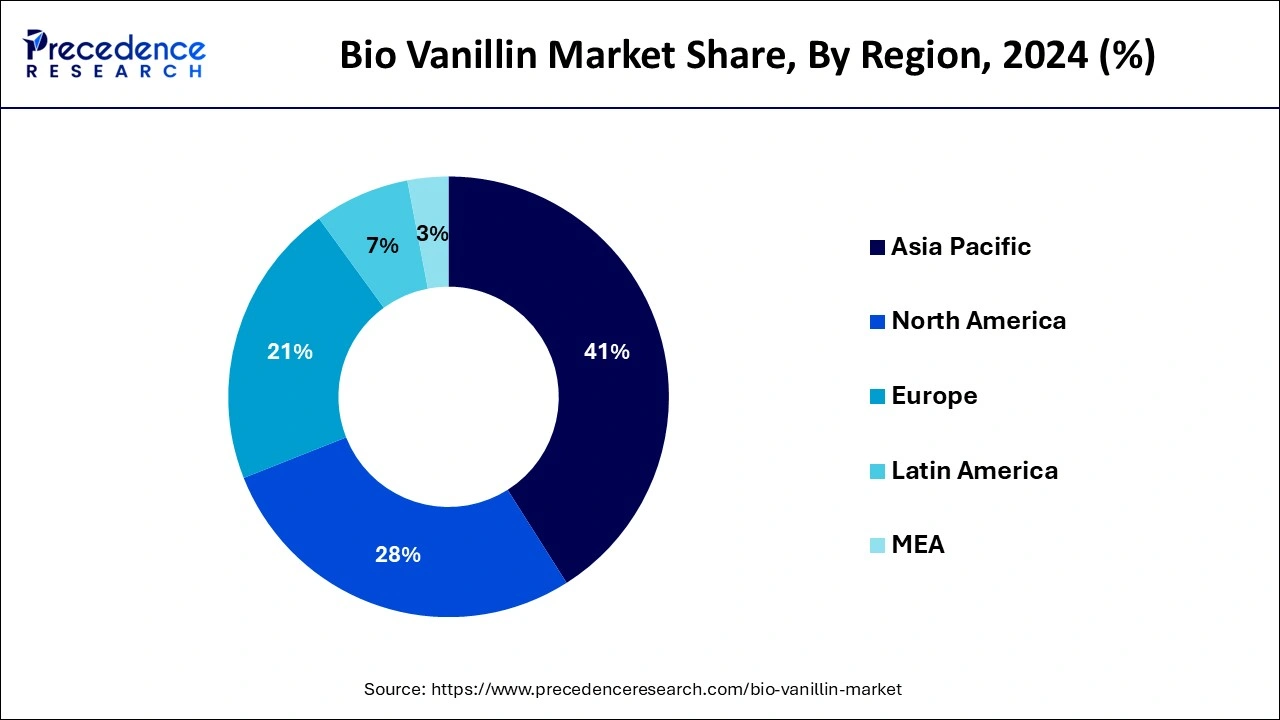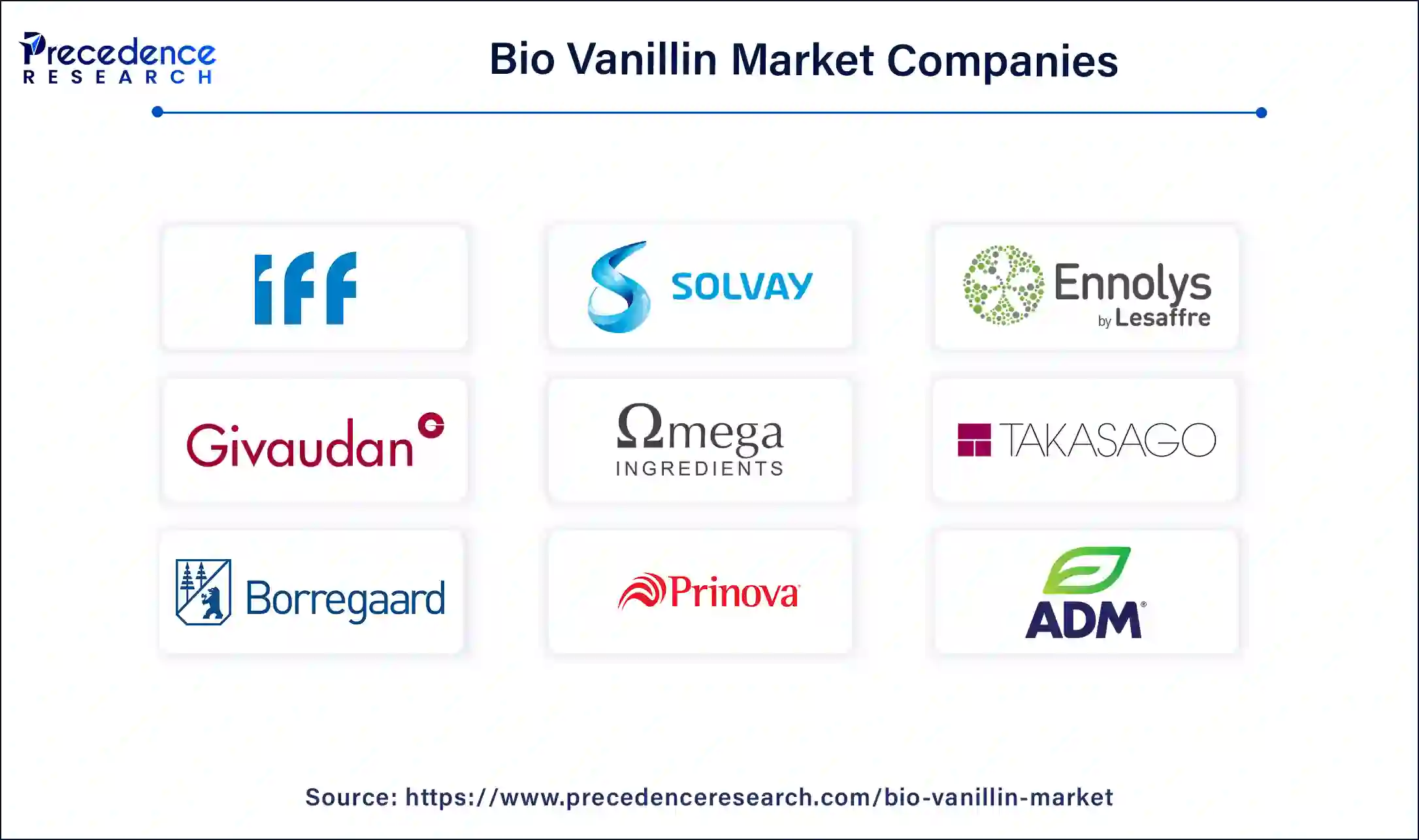List of Contents
Bio Vanillin Market Size and Forecast 2025 to 2034
The global bio vanillin market size was calculated at USD 227.72 million in 2024 and is predicted to reach around USD 379.14 million by 2034, expanding at a CAGR of 5.23% from 2025 to 2034. The global bio vanillin market growth is attributed to the increasing awareness of the adverse effects of synthetic additives and the increasing consumer preference for natural products.

Bio Vanillin Market Key Takeaways
- In terms of revenue, the global bio vanillin market was valued at USD 227.72 million in 2024.
- It is projected to reach USD 379.14 million by 2034.
- The market is expected to grow at a CAGR of 5.23% from 2025 to 2034.
- Asia Pacific dominated the global market with the largest market share of 41% in 2024.
- North America is expected to grow at the fastest CAGR during the forecast period.
- By end-use, the food and beverage segment contributed the highest market share of 64% in 2024.
- By end-use, the pharmaceutical segment is expected to grow rapidly during the forecast period.
How is Artificial Intelligence (AI) Changing the Bio Vanillin Market?
By reducing costs and enhancing production efficiency, artificial intelligence (AI) is transforming the bio vanillin industry. AI-powered tools are being used to improve the consistency of flavor profiles and optimize extraction processes. Based on consumer preferences and market trends, the integration of AI also facilitates the development of customized formulation.
Asia Pacific Bio Vanillin Market Size and Growth 2025 to 2034
The Asia Pacific bio vanillin market size was evaluated at USD 93.37 million in 2024 and is projected to be worth around USD 155.45 million by 2034, growing at a CAGR of 5.22% from 2025 to 2034.

Asia Pacific dominated the bio vanillin market in 2024. The market growth in the region is attributed to the rising demand for natural ingredients across several industries. Additionally, there is a shift towards clean-label and organic products as customers become more health-conscious. In addition, the increasing trend of premiumization and Westernization in food offerings, changing dietary preferences, and rising disposable incomes are further anticipated to create demand for bio vanillin based supplements.
In the Asia Pacific bio vanillin market, China, India, Japan, and South Korea are some of the major players. The increasing government initiatives promoting quality standards and food safety, increasing demand for natural flavoring agents including bio vanillin, the growing food and beverage industry, and the increasing shift towards healthier consumption patterns in China.

In the bio vanillin market, North America is expected to grow at the fastest rate during the forecast period. The market growth in the region is increasing consumer preference for clean-label and natural ingredients. Leading food manufacturers to use biovanillin in their products, health-conscious consumers continuously seek additives to synthetic alternatives. In addition, increasing regulatory support from agencies, including the FDA, which identifies biotechnologically produced ingredients as safe.
In addition, the U.S. and Canada are the major countries that dominated the bio vanillin market growth in the region. The market growth in the U.S. is attributed to the increasing wellness and health awareness. The demand for bio vanillin in various food products is growing continuously, as more individuals adopt plant-based and organic diets. In addition, the increasing popularity of clean-label and veganism trends are further anticipated to enhance the use of bio vanillin in the U.S.
Market Overview
The bio vanillin market deals with natural flavoring agents produced via biotechnological processes. Bio vanillin is a sustainable additive to synthetic vanillin derived from guaiacol or lignin. Its applications span various sectors, such as pharmaceuticals, cosmetics, and food and beverages. Bio vanillin is primarily used in food items such as confectionery, baked goods, and dairy products, and it enhances personal care products with its appealing fragrance profile. Furthermore, there is an increase in demand for sustainable and natural ingredients and increasing consumer preference for non-GMO and organic products.
In addition, the increasing demand for clean-label ingredients in the food and beverage industry, rising advancements in biotechnological processes, and increasing preference towards organic foods are expected to enhance market growth. Vanillin is highly valued for its aromatic properties in the personal care and cosmetics sector, contributing to the fragrance of several products. Additionally, there is a significant shift towards natural cosmetics that avoid chemical additives as consumers become more discerning about their products.
Bio Vanillin Market Growth Factors
- The rise in vegan and plant-based diets has fueled the demand for natural flavorings such as biovanillin. It is used to improve the taste of plant-based alternatives, such as non-dairy beverages, plant-based cheeses, and dairy-free ice creams.
- The increasing population of vegetarians and the increasing popularity of plant-based milk additives, such as soy milk and almond milk, are anticipated to drive the growth of the bio vanillin market.
- Various vanillin manufacturers are providing custom solutions to address the specific aroma and flavor needs of food and beverage companies, which allow for more unique and tailored product offerings, further driving the market demand.
- The rising growth of the online retail and e-commerce sector has made it easier for businesses and consumers to access biovanillin products. Online sales channels offer a wide range of options and convenience.
Market Scope
| Report Coverage | Details |
| Market Size by 2024 | USD 227.72 Million |
| Market Size in 2025 | USD 239.63 Million |
| Market Size in 2034 | USD 379.14 Million |
| Market Growth Rate from 2025 to 2034 | CAGR of 5.23% |
| Dominating Region | Asia Pacific |
| Fastest Growing Region | North America |
| Base Year | 2024 |
| Forecast Period | 2025 to 2034 |
| Segments Covered | End-use, and Regions |
| Regions Covered | North America, Europe, Asia-Pacific, Latin America, and Middle East & Africa |
Market Dynamics
Driver
The increasing preference for natural ingredients
The growing preference for natural ingredients, such as flavors, is the major driver enhancing the bio vanillin market growth. Bio vanillin is produced from natural sources such as vanilla beans and provides a sustainable and natural additive to synthetic vanillin, which is made from petrochemicals, further driving the market growth. In addition, the food and beverage industry is also a significant consumer of bio vanillin. The increasing demand for bio vanillin in several food and beverage products, such as beverages, dairy, confectionery, and baked goods, is expected to increase substantially with the evolving consumer preferences and expanding population globally. Furthermore, the increasing regulatory bodies in several emerging economies are inspiring the use of natural ingredients and flavors in food products.
Restraint
High cost of production
Due to the time-consuming extraction and complex processes, biovanillin production is more expensive compared to synthetic vanillin. This high-cost production can limit the adoption of the bio vanillin market. Bio vanillin is primarily sourced from natural products such as vanilla beans. The yield and availability of these sources can be impacted by factors such as crop disease and weather conditions. In addition, synthetic vanillin is made from petrochemicals and is more cost-effective to produce.
Opportunity
The increasing focus on the formulation of customized flavors
The significant opportunity to enhance the bio vanillin market growth is the increasing focus on the formulation of customized flavors. To provide a more vibrant flavored experience to their consumers, various flavor manufacturers have identified beneficial opportunities in the formulation of customized flavors across the globe. Bio vanillin offers a better mouth feel and pure vanilla taste when used in food products.
Bio vanillincan be one of the vital ingredients in customized flavor blends. In addition, the prevalence of market players in the food industry on innovative natural flavors is expected to enhance the growth of the bio vanillin market in the coming years. For instance, a bio vanillin manufacturer, Solvay, developed a suite of vanilla-based products under the Vanifolia brand, which is a combination of natural vanillin, Rhovanil, and other natural flavors.
End-use Insights
The food and beverage segment dominated the bio vanillin market in 2024. The segment growth is attributed to the increasing consumer demand for natural ingredients and flavors. In addition, consumers are shifting toward products that are non-GMO, organic, and free from synthetic additives, as health consciousness. This shifting preference motivates food manufacturers to enhance flavor while maintaining clean labels and incorporating bio vanillin into their formulations. In addition, the introduction of innovative products and the increase in the food service sector further increase the demand for bio vanillin and position it as a major ingredient in several applications such as confectionery, bakery, and dairy items.
On the other hand, the pharmaceutical segment is expected to grow rapidly during the forecast period. The segment growth is attributed to its comprehensive use as a flavoring agent to maintain unpleasant medication tastes. There is an increasing focus on patient compliance, as the pharmaceutical industry increases, which accelerates the need for palatable formulations. Furthermore, to improve the sensory attributes of topical treatments and oral medications. In addition, the demand for pharmaceuticals continues growing, accelerating the potential of bio vanillin market, with a rise in chronic diseases and an increasing geriatric population.
Bio Vanillin Market Companies

- International Flavors & Fragrances Inc.
- Solvay
- Ennolys
- Advanced Biotech
- Givaudan
- Omega Ingredients Limited
- Takasago International Corporation
- Borregaard
- Prinova
- ADM
Recent Announcements by Market Leaders
- In February 2024, the vanilla market is known for volatility, with prices skyrocketing or bottoming out as crop yields remain at the mercy of extreme weather conditions, fusarium infection, intermediary involvement, and political turmoil. The vanilla industry relies heavily on Madagascar, which is estimated to hold 80% of the market production of vanilla worldwide.
Recent Developments
- In June 2023, a leading global supplier of vanillin, Solvay announced that the production of Rhovanil vanillin has been accredited to comply with the mass balance accounting regime of the International Sustainability and Carbon Certification PLUS at Saint-Fons in France. Solvay's Rhovanil is widely used in home and personal care fragrances and primarily used in food and flavor applications. The aim behind this launch was to reduce the carbon footprint and consumption of fossil-based raw materials and minimize their environmental impact.
- In January 2023, a leading supplier of diphenol derivatives, Camlin Fine Sciences, launched adorr, the much-awaited adorr™ vanillin range. The launch demonstrated both their vision for the future and commitment to the flavoring industry. By delivering a safer and sustainable vanillin portfolio, adorr™ reflects its commitment to sustainability.
Segments Covered in the Report
By End-use
- Food and Beverages
- Fragrance
- Pharmaceuticals
By Geography
- North America
- Asia Pacific
- Europe
- Latin America
- Middle East and Africa
For inquiries regarding discounts, bulk purchases, or customization requests, please contact us at sales@precedenceresearch.com
Frequently Asked Questions
Ask For Sample
No cookie-cutter, only authentic analysis – take the 1st step to become a Precedence Research client